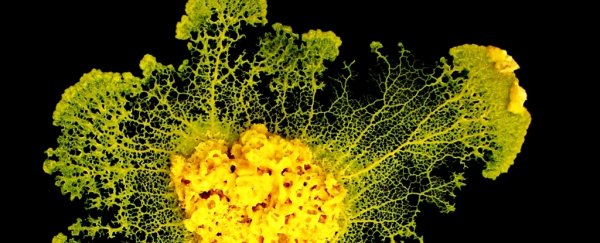Slime mould might easily be one of the strangest life forms on our planet. They are neither plants, animals, nor fungi, but various species of complex, single-celled amoebas of the protist kingdom. Sometimes they form colonies able to grow, move, and even exhibit a strange kind of intelligence.
Even without a nervous system, they are able to learn about substances they encounter, retaining that knowledge and even communicating it to other slime moulds. Now a team of scientists at the French National Centre for Scientific Research (CNRS) has figured out how: slime moulds actually absorb the substance into their veins.
Researchers at the CNRS' Centre for Research on Animal Cognition conducted their experiments on a fascinating little fellow called Physarum polycephalum, a single-celled blob with multiple nuclei, and a popular candidate for studying slime mould intelligence. (Here you can see it navigate a maze. Cool!)
The team had a clue. They had previously observed that P. polycephalum communicated information about substances with other slime mould blobs when they reached out to each other and fused their venous networks.
This implied that information was being transmitted via the veins.
For this next step in the research, a similar experimental setup was deployed. Slime mould blobs were placed near food, separated by a substance they would have to crawl over - in this case, salt.
Salt is not harmful to slime moulds, but they do not seem particularly keen on it, taking their time crawling over it compared with a salt-free path.
As previously discovered, when slime moulds ooze over salt, they seem to learn that it won't harm them, and are less recalcitrant about passing over it. This is the information they then pass on to their mates.
There were several parts to the experiment. In the first, the team took 20 blobs and cut them all in half, with the halves separated into two training regimes. In the experimental group, the blobs were fed a nutritious oat gel that had been mixed with salt for six days. The control group was fed a salt-free oat gel.
After six days, the team took measurements of the salt content in the blobs. As you'd expect, the salt group had 10 times more salt than the control group.
In the second experiment, a different set of blobs had to cross an agar bridge to reach food. The experimental group's bridge was salty, while the control group had a clear path.
After six days of training on these bridges, both groups were presented with a salt bridge. The experimental group crossed the bridge faster than the control group, which showed they were accustomed to the salt and knew it wouldn't harm them.
Finally, the team took 20 blob samples, and injected half with water, and half with a salt solution. After just two hours, the blobs that had been injected with salt were behaving like the blobs that had been on a six-day salt-training regime.
The team also investigated how long it would take slime moulds to get rid of salt once their diet was switched back to non-adulterated oat gel, and found the blobs would excrete the salt in about two days.
Something else interesting emerged, too. Slime moulds can become dormant when environmental conditions are less than ideal. Although active slime moulds excreted the salt after two days, blobs that the team induced to dormancy retained it as long as a whole month.
"We have presented the first evidence of long-term habituation in non-neural organisms and provided the first glimpse of the underlying mechanism," the researchers wrote in their paper.
"We are convinced that habituation is just one example of cognitive abilities that might be shared by most living organisms. As Godfrey-Smith would say, 'There are lots of ways to process information and control behaviour; a central nervous system is one way, but not the only way'."
The research has been published in Philosophical Transactions of the Royal Society B: Biological Sciences.
